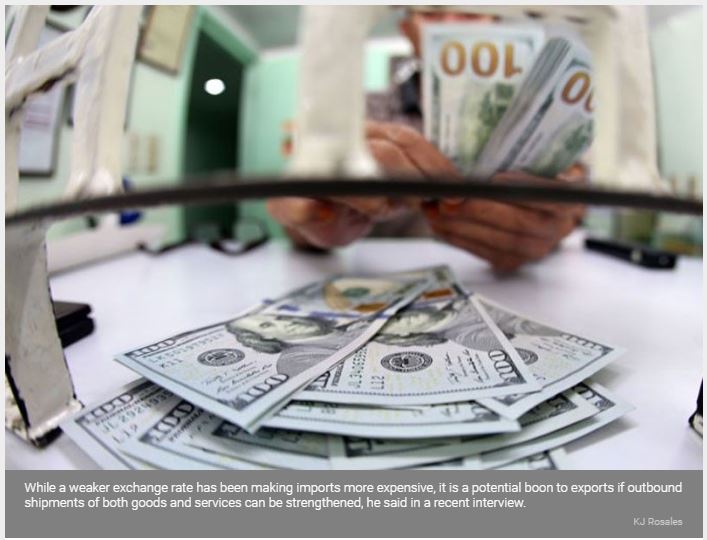Philippines: Peso weakness no cause for concern, says Pernia
MANILA, Philippines — The prevailing weakness of the peso versus the dollar should not be a cause for concern as the economy continues to benefit from it, Socioeconomic Planning Secretary Ernesto Pernia said.
While a weaker exchange rate has been making imports more expensive, it is a potential boon to exports if outbound shipments of both goods and services can be strengthened, he said in a recent interview.
He noted that an exchange rate of between 53.3 to 53.5 to a dollar would also remain beneficial for dollar earning sectors such as business process outsourcing (BPO) which earns dollars, and tourism through increased spending of foreign tourists.
It also supports consumption through remittances of overseas Filipino workers to their families in the country.
“It’s nothing to worry about. In fact, it’s oscillating between 53.3 and 53.5 so you know, as long as it does not go beyond that, it’s fine. Because there many benefits from a competitive exchange rate. Not a weak exchange rate but a competitive exchange rate. It will be good for tourism, it is an export industry but it’s a kind of service export. It will be good for BPOs. It will also be good for families receiving remittances, good for exports and good for import-substituting industries meaning Philippine industries that are producing goods that can substitute imported goods,” Pernia said.
As exports of goods remain affected by protectionist policies overseas, Pernia said this would be a good opportunity to strengthen the country’s other service exports.
“Exports are not responding as well because of this protectionist thing. There are trade tensions, which is not a good environment for exports,” he said.
“Our services exports, there is no deficit, there is a surplus. It’s the goods exports that are weak. I guess we need to ramp up tourism and other service exports to make up for the slow movement of our exports in the global market,” he added.
Trade deficit widened by 133.55 percent in April as exports decline and imports register double-digit growth. This, however, was also caused by increased importation of capital goods for manufacturing and building materials to support the government’s infrastructure program.
Exports declined 8.5 percent to $5.11 billion in April 2018 from $5.59 billion in April 2017 because of decreased outbound shipments of non-electronic manufactures such as wood products, machinery and transport equipment, chemicals, processed food and beverages, furniture and fixtures, and agro-based products.
Imports, on the other hand, surged 22.2 percent to $8.73 billion in April 2018 from $7.14 billion in April 2017. This followed a marginal growth of 0.2 percent in March 2018. Growth was attributed to an increase in inbound shipments of capital goods, raw materials and intermediate goods, consumer goods, as well as mineral fuels and lubricants.
This brought the balance of trade in goods to a $3.62 billion deficit in April 2018, more than double the $1.55 billion deficit in April 2017.
Pernia, however, is optimistic that exports would recover in the coming months as indicated by the robust performance of the manufacturing sector in May.
Growth in factory output as measured by the Volume of Production Index (VoPI) rose by 19.8 percent in May, reversing the negative growth of 0.6 percent in May 2017. Growth was led by printing which registered a growth of 117.8 percent. Expansions in food manufacturing, petroleum products, construction-related manufactures, export-oriented products, and transport equipment also supported growth during the period.
The Value of Production Index (VaPI), meanwhile, registered a growth of 21.3 percent in May from a negative growth rate of 2.6 percent in the same month last year.
Source: https://www.philstar.com/business/2018/07/10/1832046/peso-weakness-no-cause-concern-says-pernia#6F0R2BQlcBhXfCrs.99


 English
English




